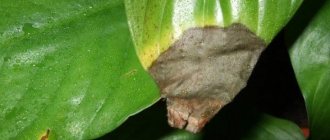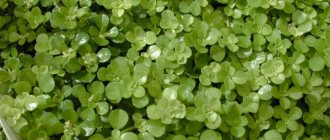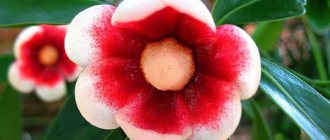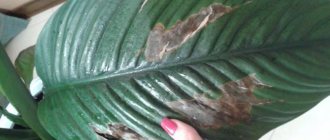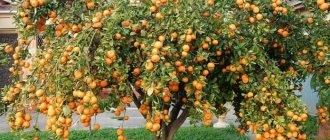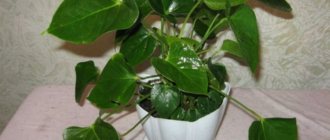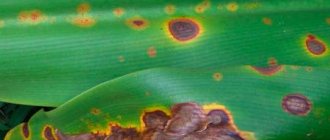Pilea care at home Pruning and replanting Propagation by cuttings and seeds
An ornamental foliage plant that does not require special care?
This is a pilea with its unique shiny leaves, dissected by veins and collected in corrugated shapes, with a wide variety of shades. The plant looks beautiful in hanging flowerpots and pots and fits perfectly into any interior style. The beauty will forgive you for temporary forgetfulness and will not die if there is no watering for a long time.
It is not affected by diseases and pleases the eye all year round with its unique greenery.
Brief description of cultivation
- Bloom. It is observed in June–October, but the flowers do not have high decorative value. At home, Pilea is grown as an ornamental foliage plant.
- Illumination. A large amount of bright diffused light is needed. Do not expose the flower to direct sunlight.
- Temperature conditions. Throughout the year, the air temperature in the room should be about 25 degrees. But there are species that are more comfortable in winter at temperatures of about 10 degrees. However, most species may suffer when temperatures drop to 17 degrees or below.
- Watering. In the spring-summer period, the flower needs to be provided with such a watering regime so that the soil mixture in the pot is slightly moist (not wet) all the time. In winter, watering is carried out only when the substrate is 1/5 dry in depth.
- Air humidity. It should be elevated. Experts advise placing open vessels filled with water next to the flower, or you can pour wet pebbles into the tray. The foliage should not be moistened.
- Fertilizer. In the spring-summer period, fertilizing is carried out once every 7 days and for this purpose mineral complex fertilizers for decorative and deciduous plants are used. In winter, the amount of fertilizing is reduced to once every 4 weeks.
- Rest period. Observed in October–February.
- Transfer. The flower is replanted every year at the beginning of the growing season.
- Soil mixture. It should be humic, slightly acidic or neutral. Its composition should include sand, peat, humus and turf soil in equal parts.
- Reproduction. By cuttings and seeds.
- Harmful insects. Mealybugs, thrips, spider mites and scale insects.
- Diseases. Problems with Pilea foliage can only arise if it is not properly cared for.
How to care for indoor Pilea
Pilea cadieu photo
Lighting
The best lighting for Pilea is intense, diffused light. It is preferable to choose eastern or western windows, but the plant feels comfortable almost anywhere, calmly tolerating shade or direct sunlight.
In winter, it is advisable to move pots with plants from northern windows to southern ones to increase the intensity and duration of lighting.
Many gardeners are happy to decorate bathrooms, kitchens, and even hallways without natural light with Pilea. The beauty fits harmoniously into interior compositions, bringing freshness and comfort to them.
Air temperature
Pilea feels more comfortable in cool rooms at a temperature of 15-18 ° C, so keep it away from heat sources and try to place it in the coolest rooms. In summer, the pilea can be taken out to the loggia or to a shady place in the garden, protecting it from the scorching sun.
How to water a Pilea
The plant is responsive to regular watering without excess, but easily tolerates short-term drought. The main thing is not to make it a habit, watering the beauty at least a couple of times a week. The water collected in the pan should be drained immediately so that the moisture does not stagnate, causing the development of rot. Water the pilea only when the top layer of soil has dried a couple of centimeters. To check the humidity, you can insert a thin stick into the ground and pull it out, looking to what depth it has dried out. In general, it is better to water the pilea more often, but less, than rarely, but abundantly.
Air humidity
Considering that the plant does not like high temperatures, in hot weather it is necessary to increase the air humidity. This is achieved by placing it next to an aquarium or an air humidifier, or containers with sphagnum moss.
Pinching and trimming
To avoid annual rejuvenating transplants and radical pruning, it is recommended to constantly pinch the Pilea, cutting off the apical parts of all its shoots. This procedure inhibits the growth of bushes, maintaining a compact decorative appearance.
The video will tell you how to care for Pilea Cadieux:
Signs and superstitions
Do you believe in signs and superstitions associated with this flower?
I believe I don't believe
Pilea has a positive effect on the atmosphere in the home. When around her, people's anxiety decreases and their mood improves. Suitable for those who practice: in her presence it is easier to enter a meditative state.
It is a talisman for those born under the sign of Pisces. It is believed that Pilea Peperomiiformes has special energy and attracts money into the house, which is why it is also called the Chinese money tree.
According to floral feng shui, you should not keep fading plants at home - they take away vital energy. Give flower pots a place away from the bed and sofa. It is better not to place plants in the bedroom at all. But an excellent solution would be to fill empty niches and corners with them.
Expert opinion
Mokhov Andrey Petrovich
Graduated from KubSAU, specialty: agronomy
Pilea is not suitable for growing as a bonsai, but feels great in open and closed florariums.
Rejuvenating transplants and dividing the Pilea bush
The main disadvantage of the plant is its rapid degeneration. By increasing its mass, the bush grows, the shoots clog each other, become thinner and longer, lose their decorative appearance, exposing the lower part. As soon as you see that the bush has aged, this is a signal that it is time to take it out of the pot and divide it. Usually transplants are carried out annually.
The procedure is performed at the end of the rest period from the beginning of spring to the end of summer at any convenient time. Before transplanting, the bush is pruned, leaving only a third of the length of the old shoots. Such radical pruning promotes the forcing of new young shoots and branching of the plant.
Cut apical cuttings are also used to renew planting material, rooting them in a moist substrate.
How to transplant a Pilea, look at the video:
Types of pili
Pileas occupy a special place among compact indoor plants. They are indeed small, modest in volume and very neat-looking crops that are used to decorate rooms with attractive accents. The magnificent foliage makes Pileas appear precious and striking. Pileas got their name for their ability to spray, or rather scatter pollen over amazing distances. But in indoor culture, it is impossible to appreciate such talents, unlike the beauty of the leaves.
Pileas are charming perennial and sometimes annual members of the nettle family. These are tropical crops in character and origin, which, despite their southern roots, prefer cool growing conditions. The height of the saws is limited to a maximum of 30-40 cm, but most beauties are content with more compact sizes.
The shoots are straight or creeping, thin, densely branched from the base. The leaves sit opposite, depending on the species, they can be tiny, just a few millimeters, or larger, up to several centimeters in length. Even the edge of the leaves can be either solid or jagged. Not to mention that lanceolate, oval outlines are as common as perfect circles. The flowering of pili is inconspicuous: small, unisexual, collected in clusters of inflorescences located in the axils of the leaves, the flowers of the plants are almost inconspicuous.
One of the main advantages of pili is variety. Among these beauties there are such original plants that it is impossible to guess their relationship. Some pili have luxurious, velvety leaves, while others have glossy leaves. And the difference in shapes and even sizes can completely confuse anyone.
The velvety beauty Pilea crassifolia is one of the most popular Pileas. Reddish-green leaves with a bumpy, embossed surface and light stripes along the edges seem like luxurious velvet, powdered with light dust, a precious decoration.
Pilea is a fairly unpretentious plant that is easy to care for at home. That is why it is very popular among novice gardeners.
Pilea prefers temperatures up to 25 degrees. It is undesirable for most species to lower the temperature below 20 degrees. Drafts are also contraindicated for Pilea, especially in winter.
You can determine the frequency of watering by looking at the soil in which the Pilea grows. If the top layer has dried slightly, then the time has come. In winter, it is worth waiting 1-2 days before watering when the soil is dry. Pilea will tolerate drought better than overwatering. When the soil is waterlogged, especially in winter, the leaves may begin to turn pale and wither. It is better to take soft, settled water at room temperature for irrigation.
The plant loves high humidity, but do not spray it, as this can harm the leaves. It is better to place the pot in trays with expanded clay or sand that are filled with water. In this case, the bottom of the pot should not touch the water. You can also place containers with wet moss and sand or water near the plant.
Pilea prefers humus soil. You can purchase ready-made mixtures, or you can mix yourself one part of sand and peat soil and two parts of leaf and humus soil. Be sure to use drainage. Pilea also grows well hydroponically.
Feeding is carried out once a week in summer, once a month in winter. Liquid fertilizer for decorative indoor plants is suitable for this purpose.
Pileas can be replanted annually; it is best to do this in spring or summer. These plants do not need deep pots, as their root system is quite compact. Pots up to 10 cm deep or pallets are ideal. Since Pilea is a plant with disorderly growth, during replanting, young shoots must be plucked and old shoots cut off. You can grow a new flower from the cut shoots. Pilea propagates by seeds or cuttings.
To propagate by cuttings, it is necessary to cut cuttings from old shoots. Their length should be 8-10 cm. It is necessary to rid them of leaves, and then plant them in a pot with sand or loose soil. The pot must be covered with a bag, but so that the cuttings do not touch it, and put in a warm place. After the cuttings will take root, the bag can be removed, and after about a week the pilea can be transplanted into a permanent pot. To obtain a more lush plant, you can plant several cuttings in a pot.
Some species are capable of producing seeds and reproducing by self-sowing.
We recommend watching the video for more details on how to replant Pilea.
Possible problems in care
- When there is insufficient lighting, the leaves lose their brightness and their tips dry out.
- When overwatered, the plant withers and the leaves begin to fall off.
- Stress from hypothermia (below +10°C) or too long a drought at high temperatures will cause the leaves to wrinkle and dry out.
- If the sun is too hot, sunburn is possible in the form of brown, drying spots on the leaves and trunk.
- Bare lower parts of the branches are a sign of degeneration of the bush and a signal for the need for its rejuvenation.
The most popular types of Pilea plants and photographs of these species
About 400 species of Pilea can be found in nature. Many of these species are suitable for growing indoors, including Pilea Cadieux, Pilea parvifolia, Pilea involucres, Pilea peperomioides, Pilea lebanese and Pilea compressa. Pilea is a versatile plant; it can be used both as a hanging flower in a flower pot and as a regular flower in a pot. Many species are distinguished by rather disorderly growth, so young shoots must be pinched and grown shoots trimmed.
Pilea Cadieux
Pilea cadieri is a bushy herbaceous plant. Its stems are straight, flexible, thin, reaching a height of 40 cm. Young shoots first stand upright, then bend under their own weight and take on an ampelous shape. The leaves are oval, pointed at the ends, up to 5 cm wide and reach a length of 10 cm. They are dark green with silver spots over the entire surface, light green below.
Because of its unusual color, the Germans nicknamed it “silver pilea”, and the British called it “aluminum plant”. The flowers of this species are small and inexpressive white-greenish in color. The dwarf version of Cadieu's Pilea - "Minima" - is popular among gardeners. Its height does not exceed 10 cm.
Pilea parvifolia
Pictured is small-leaved Pilea
Small-leaved Pilea (Pilea microphylla) is a perennial herbaceous plant. This species is low-growing and reaches a maximum of 15 cm in height with highly branching spreading shoots. The leaves grow densely on the shoots, they are quite small (up to 0.5 cm), round, light green in color, convex on top. The curved branches resemble the shape of a fern. The flowers are small, collected in the axils of the leaves in small shields. It is this species that emits a cloud of pollen when touched in the summer.
Pilea wrapped
Pilea involucrata is a bush-type plant with erect stems. It reaches a height of up to 30 cm. The leaves are tuberous, oval in shape with pointed ends. The color of the leaves is light green with brown veins. This species is the source for many hybrid forms, including Pilea repens.
Pilea peperomioides
Peperomoides Pilea (Pilea peperomoides) is a bushy plant reaching 45 in height. The leaves are held by long cuttings, which, when growing, bend under the weight of the leaves. The color of the leaves is slightly spotted green, round in shape, diameter about 7 cm.
Pilea Lebanese
Lebanese Pilea (Pilea libanensis) is a rather unpretentious hanging plant with long brown shoots. They produce oppositely arranged leaves, the length of which is no more than 1 cm. The color of the leaves is silver-green above and green below. It is better to plant several cuttings of Pilea Lebanese in one pot to make it lush.
Pilea compressa
Pilea depressa is very similar to Pilea coinifolia. The main difference is the size of the leaves; in Pilea compressed it does not exceed 6 mm. This is a groundcover, creeping species. As it grows, it forms a mat, completely covering the ground. The color of the leaves is light green. A very unpretentious plant, it can survive low temperatures in winter (up to 8 degrees).
Growing Pilea from Seeds
Pilea is propagated by seeds extremely rarely, and only if purchased in a store. Sow on the surface of the soil, lightly sprinkle with soil. Moisten with a spray bottle and cover with glass or film. A greenhouse is needed to increase the level of humidity at which seeds germinate better.
When shoots appear, the shelter is removed and moderate watering is continued. When the plants produce two or three true leaves, they should be planted in separate containers. When they reach a height of 10-12 cm, the seedlings are ready to be planted in a permanent pot. It is better to replant them using the transshipment method so as not to cause unnecessary stress.
Leave a comment on “Pilea care at home Pruning and replanting Propagation by cuttings and seeds”
Pilea flower - home care, photos of Pilea and types, houseplant Pilea - propagation and replanting
Possible difficulties
Bouvardia flower: home care and methods of propagation
Problems that may arise when growing crops are the result of errors in maintenance:
- the foliage wrinkles and begins to crumble when the air temperature is too high or too low, as well as during a long period between waterings (the flower begins to dry out from lack of moisture);
- the leaves turn black and fall off, the lower part of the shoots rots. The reason is excessive watering;
- Yellow and brown spots appear on the leaves. The reason is direct sunlight;
- lack of light leads to fading of the silver stripes on the leaves, as well as to crushing of the leaves and stretching of the shoots;
- if the shoots become bare (the lower part of the stems loses their foliage), this means that the plant needs rejuvenation.
Pilea - description
More than 400 species of the genus Pilea (lat. Pilea) are found in the nettle family (Urticaceae). There are both annual and perennial species. Plants are herbaceous or subshrubs. They grow in tropical zones all over the Earth except Australia.
These are hardy ornamental foliage plants that grow up to 40 cm in height. They grow well in warm flower beds, winter gardens and shop windows. Pilea Cadieu grows very quickly, therefore it is valued and used in arranging plant compositions.
The flowers of the plants are unisexual and small, often growing in racemose axillary inflorescences. Pilea spreads its fruits in a very unusual way. This is similar to catapulting - the sterile stamens grow greatly by the time of fruiting and only slightly support the fruit that hangs over them. When the fruit ripens, the connection between plant and fruit becomes weak. Staminodes (sterile stamens) straighten and throw the fruit up to 100 meters away!
general description
Pilea is most often a herbaceous plant, rarely a subshrub, growing up to 40 cm in height. The stems can be erect or creeping, highly branched, with opposite, entire leaves, the size of which ranges from several millimeters to several centimeters. The shape of the leaves can be round, oval, lanceolate, with a smooth or jagged edge, often variegated in color.
The flowers are unisexual, inconspicuous, small, located in racemose inflorescences. Pilea seeds “shoot” when ripe and scatter almost 100 m.
Planting and caring for Pilea
- Flowering: from June to October, but the flowers are not attractive. In indoor culture, the plant is grown as an ornamental foliage plant.
- Lighting: bright diffused light without direct sunlight.
- Temperature: The optimum temperature throughout the year is 25 ºC, but there are species that are comfortable at 10 ºC in winter. For most species, the lower temperature limit is 17 ºC.
- Watering: in spring and summer - as the top layer of soil dries out: the substrate in the pot should be slightly moist all the time. In winter, the substrate is allowed to dry to one-fifth of its depth.
- Humidity: high. It is recommended to keep the plant on a tray with wet pebbles or surrounded by vessels with water. Pilea cannot be sprayed.
- Feeding: from the beginning of spring to the end of summer - once a week with complex mineral fertilizer for decorative deciduous plants. In winter - once a month.
- Dormant period: from October to February.
- Transplantation: annual, at the beginning of active growth.
- Substrate: humus, neutral or slightly acidic reaction. Composition: peat, sand, turf and humus soil in equal proportions.
- Reproduction: seeds and cuttings.
- Pests: mealybugs, thrips, spider mites and scale insects.
- Diseases: problems with leaves arise due to improper care and maintenance.
Pests, diseases, control measures
Both harmful insects and diseases attack the pilea when it is weakened - this happens due to non-compliance with the conditions of maintenance. To prevent the plant from getting sick, you need to properly care for it and regularly inspect the leaves for parasites.
| Pests and diseases | Causes | Symptoms | Treatment | Preventive measures |
| Rotting of the stem and root system. | Excessive soil moisture against a background of too low air temperature, which leads to infection of the roots and stem by fungus. | A drooping, flabby plant with crumbling foliage. The stem near the roots is abnormally soft, swollen, and the root system is rotting. | Transplantation into new soil and parallel treatment with Topaz. | Observe temperature standards and the optimal watering schedule for the plant. |
| Spider mite. | The most suitable conditions for insect damage to Pilea are heat, dry soil and insufficient air humidity. | Withering, flabby and crumbling leaves, dotted with dots (traces of tick bites through which it drinks the plant juice). You can see cobwebs on the underside of the foliage and on the stems. | The use of medications such as Fufanon, Decis or Aktara. | Maintain normal temperature and humidity. As an additional way to combat mites, spraying the pilea with water is suitable, after which you need to shake off the moisture from the leaves and let them dry. |
| Mealybug | The plant weakens, stops growing, shoots and foliage become covered with a sticky whitish substance. | Use the drug Aktara. | ||
| Thrips | Spots of dead tissue on the leaves, curled, dried shoots, and in severe cases a light coating covering the foliage. All these signs indicate the presence of thrips larvae, drawing juices from the leaves. | Treatment with Fitoverm at a concentration of 2 ml per 200 milligrams of water. After the procedure, wrap it in a plastic bag and leave it for a day. Another option is to use Actellik (1 ampoule is diluted in a liter of water, and the room is ventilated - the drug has a specific smell). | Treat with celandine tincture, remove the top layer of soil and replace it with fresh one, set sticky traps for insects. | |
| Shchitovka | Dried, curled, deformed leaves covered with brownish-orange tubercles (scale insect shells). | Two (seven days apart) treatment sessions with medicinal agents, such as Fitoverm or Actellik. | Wipe the leaves with a cloth soaked in soapy water to remove the shells, and check the plant again after six to seven days. |
Pilea care at home
Lighting
Pilea needs diffused light - bright, but without direct rays of the sun. It is preferable to place the home pilea on eastern or western windows. When placing the pilea on the south side, you need to provide diffused light or place it away from the window. Pilea can be taken out into the open air in summer, providing shading from direct rays. In winter, the plant also needs sufficient lighting, because... with its deficiency, Pilea at home can change the color of the leaves, which will entail a decrease in the decorativeness of the plant.
Temperature
The best temperature for the plant throughout the year is up to 25 °C. Pilea cadiera feels good even at a temperature of 15 °C in winter, and Pilea peperomioides - at 10 °C. For other species, the air temperature should not fall below 17 °C. Drafts in winter can destroy the plant.
Watering the Pilea
In spring and summer, as soon as the top layer of soil dries out, you need to water the indoor pilea with settled water. In winter, water a couple of days after the top layer of soil has dried. Pylea is more harmed not by drying out the substrate, but by excessive watering. The soil should be slightly moist all the time. If the plant is overwatered, the leaves may turn pale and become limp - especially in winter.
Related article: Plumeria flower: home care, photos and types, growing from seeds
Spraying Pilea
The indoor Pilea plant requires high humidity, so you need to monitor the air humidity in the room. Because spraying the leaves is not recommended due to the fact that the leaves may lose their decorative properties; the plant must be placed on a tray with wet expanded clay or pebbles, but only so that the bottom of the pot is not immersed in water. Another option is to place containers of water next to the plant.
Feeding Pilea
From the beginning of spring to the end of summer, the plant needs to be fed every week. During the autumn-winter period - monthly. Feed with flower fertilizer; concentration - as specified by the manufacturer.
Pilea pruning
Homemade Pilea grows very quickly. Because young specimens are much more decorative, then every year the plant must be pruned, and the pruned shoots used for propagation by cuttings. And in order for the bush to be more lush and not exposed, you need to periodically pinch its shoots.
Pilea transplant
Pilea transplantation indoors is carried out annually. Humus soil, neutral or slightly acidic, is required. A mixture of peat, sand, turf and humus soil (1/4 each) is suitable. They are transplanted into small pots because the roots of the pilea grow superficially. To prevent the plant from dying from excess moisture in the soil, you need to ensure high-quality drainage. The indoor Pilea flower is great for growing hydroponically.
Pilea propagation
Reproduction is possible by cuttings and seeds. Some types of Pilea can reproduce independently by seeds. Propagation by cuttings is possible throughout the year. Cuttings take root either in loose soil, or in sand, or in water. Rooted Pilea cuttings are planted in a shallow container with a mixture of 1 part deciduous soil, 1 part greenhouse soil and 1 part sand.
Reproduction
Pilea is propagated in 2 ways:
- By cuttings.
- Seed.
Cuttings
The simplest and most popular method among gardeners. For propagation, apical cuttings are used. They are cut throughout the year, even in winter.
The procedure is carried out as follows:
- Choose a thin shoot.
- Cut a cutting up to 10 cm from its top with 2-3 pairs of leaves.
- Place the cuttings in water for rooting. It is possible to plant in a loose substrate, for example, sand, to a depth of 5-6 cm.
- As necessary, water is added and the substrate is moistened.
- After the roots appear, the cuttings are placed in cool conditions for hardening for 7–14 days.
Growing from seeds
The seed method is only suitable for certain types of Pilea.
It is carried out like this:
- Before planting, moisten the substrate.
- Seeds are placed at a depth of 1–1.5 cm.
- The container is covered with film or glass.
- The crops are periodically sprayed with warm, settled water from a spray bottle.
- Every day the shelter is removed for some time for ventilation.
- After the sprouts appear, the cover is removed.
- When 2 leaves appear, a pick is made.
- After the formation of 5-6 leaves, transplantation to a permanent place is organized.
Diseases and pests of Pilea
Pilea leaves dry out and fall off. At temperatures above 27 °C, or below 12 °C, leaves may dry out, wrinkle and eventually fall off. Another reason could be dry soil.
Pilea leaves wither. If you water excessively, the soil will not have time to dry out, which will lead to the appearance of limp leaves, which will further turn black and fall off; the stem will become soft.
Pilea leaves turn pale. Excessive light will cause the Pilea leaves to become limp, pale and slightly translucent.
The edges of the Pilea leaves dry out and turn brown. There is not enough lighting - the edges of the leaves turn brown and dry out, and the leaves themselves lose color, new leaves are small; the shoots will stretch out.
Spots on Pilea leaves. Sun burns will lead to the appearance of yellow spots first, and then brown ones.
Pilea leaves fall off. The lower leaves fall off, but this is normal for Pilea. It is best to take cuttings from the plant and root it like a young one.
Pilea pests. Mealybugs and thrips feast on the plant. Pilea is also damaged by scale insects and spider mites.
Pilea propagation
Pilea is very easy to propagate by cuttings, which can be done all year round. In order to get a new copy of the plant, just cut the cutting and place it in a container with water, and within 2-3 weeks you will see the roots. The cuttings are planted in the ground when the roots reach 1-2 cm. You can plant several copies of Pilea in one container, which will only add decorativeness and bushiness to the plant.
Pilea depressa.
Types of Pilea
Pilea cadierei (silver Pilea) / Pilea cadierei
Lives in Southeast Asia in tropical forests. This perennial herbaceous plant grows up to 40 cm in height. Young stems are erect, mature stems are lodging, highly branched, succulent and bare. Beautiful leaves on petioles, elongated oval in shape and pointed towards the apex, have three veins; leaf width is up to 5 cm and up to 20 cm in length. In England this flower is called the “Aluminum Plant”, and in Germany it is called the “Silver Pilea”. The reason is two silvery broken lines running along the green-blue or bright green leaf plate. The flowers of the plant are small, collected in racemose axillary inflorescences. Slender young shoots begin to curl with age, taking on the appearance of an ampelous shape. The plant needs to be pinched to increase bushiness.
Pilea microphylla
Perennial plant, herbaceous. Grows up to 15 cm in height. The shoots are branching, densely covered with leaves, touching the ground, and take root easily. Beautifully curving branches look like fern fronds, densely covered with tiny glossy light green round and oval leaves (up to 0.5 cm in length). Corymbose inflorescences of small flowers, both bisexual and heterosexual, are collected in the axils of the leaves. This species is also called “Artillery” or “Cannonier” due to the fact that the staminate flowers form a cloud of dust when the anthers open. The Pilea will release a haze of pollen when touched in the summer.
Pilea nummulariifolia
This is a perennial herbaceous type of pilea, with 40-centimeter shoots creeping along the ground. The leaves are round and light green in color. As the plant develops, it grows and covers the ground.
Pilea involucrata
This pilea is a low bush (about 30 cm). The stem is erect; leaves are up to 7 cm long, oval with a pointed apex, opposite. The leaves are light green, brown and lumpy along the veins. This species is widely used for hybridization.
Pilea peperomioides / Pilea peperomioides
The plant has a very rigid stem and rounded leaves.
Pilea repens
The small bush has creeping stems, and the bush itself grows to a maximum of 25 cm. The leaves are glossy, up to 2.5 cm long, rounded, and the edges of the leaves are wavy; the leaves are arranged oppositely. The color of the upper part of the leaves is dark green with a copper tint, the lower part is purple.
Pilea spruceana
This Pilea is native to Venezuela and Peru. The leaves are arranged oppositely; leaf shape – round or ovoid, rotated 180°, or sharp or blunt at the top; petioles are short. The color of the leaves is shades of silver or bronze.
Pilea "Bronze" / Pilea "Bronze"
A bush with erect stems, growing up to 30 cm in height. The 7-centimeter leaves are arranged oppositely and have an oval shape with a point at the top. The leaves are wrinkled, silvery, and dark green along the veins. Another color of the leaves is a silver stripe along the midrib, and the edges are dark green.
Related article: Pachira flower: home care, photos and types, growing from seeds
Pilea "Norfolk" / Pilea "Norfolk"
The origin of this form remains a mystery. This is a perennial herbaceous plant. Adult shoots are lodging, and young shoots are erect. The leaves are covered with tiny bristly hairs, velvety and wrinkled, bright green with red-brown veins.
Pilea "Silver Tree" / Pilea "Silver Tree"
It is not clear where this hybrid came from, but this very beautiful perennial pilea is actively climbing. The leaves are oval-shaped, the edges are jagged. The color of the leaves is green-bronze, there is a silver stripe in the middle of the leaf, and the rest is covered with the same spots. Leaves covered with red and white hairs.
Description of the flower
Perennial evergreen shrub plant 30-40 cm high. The most common species of the genus Pileum (Pileum) of the Nettle family. The stems are thin, flexible, and strongly branched at the base. Young stems are erect. With age, they bend, fall off, and lose foliage near the base.
Spectacular leaf pattern
The leaves are oblong, long (10 cm long, 4 cm wide) with a pointed tip and base. Attached to the stem by short petioles. The surface of the leaves is glossy, uneven and bumpy. On the sides of the main vein there are two convex wide interrupted stripes of silver color. Two more stripes with the same inclusions run along the edges of the leaf plate. Against the background of lush green leaves, this pattern looks very impressive. The upper young leaves are lighter in color compared to the lower ones.
Pilea Cadieu has a dwarf small-leaved hybrid of a compact form up to 10 cm high.
In nature, Pilea Cadieu is found in the tropics of Indochina, growing in shaded areas, in the lower tier of tropical forests, protected from the sun.
For your information! Indoors, Pilea Cadieu produces volatile biologically active phytoncides that suppress the proliferation of staphylococcus bacteria. It can reduce the number of these harmful bacteria by 50-70%.
Appearance
Peperomioides Pilea (Pilea Peperomioides) looks like a small shrub up to 50-55 cm high. The stem is quite fragile and has a high growth rate. Its top turns into several shoots, forming a lush spherical crown.
The leaf blade of the Pilea is round and fleshy, attached to the stem with a thin long stalk. Its surface is glossy with a slight shine. Young leaves are light green. As they grow, they darken. Pale red small flowers are collected in small clusters.
Pilea flowering
Chinese money tree
If previously only Crassula and Zamioculcas were called money trees, then with the arrival of Pilea in Europe, the number was replenished. The second popular name for the plant is Chinese money tree, or Japanese dollar.
For your information! This is due not only to the energy that the plant emits in the house, but also to the shape of the leaves, which resemble large green coins.
Homeland and territory of distribution
In the wild, Pilea peperomioides grows in India and some areas of China. It can be found in the mountains or other places with fertile soils or light peaty soil.
The plant appeared in Europe not so long ago, in 1946. Travelers from Sweden brought it there. It was not cultivated in the wild, but immediately began to be bred as a houseplant.
Pilea: home care
Pilea is a plant that does not require much attention from you, and which beginner gardeners can care for. There are many varieties of it. What’s interesting is that each type of pilea is strikingly different from each other. And if you were not specifically interested in other species besides the one you have, then when you see a pilea of another species, you may not even realize that it is essentially the same plant as yours. Of particular beauty are the Cadieus Pilea (cadieri) and the Norfolk Pilea involucres. But the most popular species are peperomyoid and small-leaved, although in my subjective opinion, they are inferior in appearance to the above-mentioned varieties.
Problems and difficulties during cultivation
During planting and care, flower growers may encounter the following difficulties:
- If the temperature and dry air are too high, pests may appear: spider mites, thrips. Insecticides work well against them;
- Requires constant pruning and pinching. If this is not done, the bush will become untidy;
- with a lack of lighting, the shoots stretch out, new leaves become smaller;
- in excess of light, the leaves wither and their pattern turns pale;
- if the leaves dry, it means the air in the room is too dry;
- If the foliage droops and the plant seems to wither, it is urgent to reduce watering.
Pilea Cadieu is an incredibly beautiful and unpretentious houseplant that can decorate any home. Besides, it is very useful. At home, the Cadieu Pilea requires minimal care, but this does not mean plant it and forget it. You will still have to make an effort, even minimal. In gratitude for this, the flower will bestow its lush and unusual greenery.
Pilea care
Despite the diversity of species and varieties of this plant, the care and maintenance conditions are basically the same for all.
Content temperature
Pilea is a heat-loving plant and normal room temperature is quite acceptable for it. It is believed that the most acceptable temperature for Pilea lies within +20-25 degrees. But for species such as cadieri, peperomyoid and small-leaved Pilea, it is desirable to lower the temperature in winter to +16-18 degrees. This decrease is desirable, but as practice shows, it is not at all necessary if normal air humidity is constantly maintained. Protect the Pilea from drafts. In summer, you can safely take it outside, protecting it from the burning sun, wind and rain.
Lighting and location
Try to provide her with a lot of light, protecting her from direct sunlight. Considering the high decorative features of the pilea, on the windowsill, covered with a curtain, it will look somewhat out of place. It is better to place the pilea next to the window. I note that it looks most impressive against a dark background, in a composition with bright colors.
Keep in mind. With excessive lighting, the plant becomes discolored, the leaves become faded and unattractive.
Watering and air humidity
In summer, constant soil moisture should be maintained. Water immediately after the soil dries out slightly. In winter, reduce watering. Water about a day or two after the soil dries out. Pilea tolerates dry soil more easily than excess moisture. A flooded plant may have roots that rot.
For comfortable existence of the pilea, high humidity is necessary. But spraying it is not recommended. This will not affect her health, but it will make her lose her attractiveness and look unkempt. This especially applies to Pilea varieties that have velvety leaves. Water on the leaves can cause irreparable harm to them. Most often, problems with humidity arise during the heating season, when the indoor air is too dry. To maintain the required humidity, you can place the pot with the pilea in a tray of water on pebbles, expanded clay, or moss. The bottom of the pot should not touch the water. You can place the pilea next to plants that you spray regularly. If the pilea is grown in a suspended state, then you can use a capacious flowerpot in which the pot with the plant is placed. The space between the walls of the flowerpot and pot is filled with wet moss.
Top dressing
Due to the lack of necessary elements, the leaves of the Pilea become very small. From March until the end of summer, feed it once every ten days. Specialized fertilizers are sold for Pilea, but it is also acceptable to use universal fertilizers “For indoor plants.” With the onset of autumn and until spring, fertilizing is gradually reduced, but I do not recommend stopping it completely. Reduce them to once a month.
Pilea transplant
It is usually recommended to replant an adult flower every two or three years. But we advise you to do this every spring. The roots of the pilea are located close to the surface of the earth, therefore, the pot needs to be shallow and wide. You will be convinced of this already when you first transplant the Pilea, and in the future you will be able to select a suitable pot. You can buy ready-made soil for pilea; there is plenty of choice. For those who want to make their own soil for pilea, we recommend a fairly simple and popular composition.
- Leaf soil - three parts
- Humus - one part
- Peat - one part
- Sand - one part
Pilea pruning
You may have noticed that in some public organizations, where plants are cared for as needed, pileas are a tangle of intertwined branches and leaves. Often with long, half-naked lashes. Pilea grows very quickly. Pruning the pilea and pinching the tops of the vines should become regular. Pilea tolerates pruning easily.
Pilea propagation
The cuttings that remain during the pruning process can simply be placed in water, and soon their own roots will appear on them, after which the young pileas can be planted in pots with soil. It's that simple. Moreover, Pilea can be propagated throughout the year. To achieve the greatest decorative effect, plant several cuttings in one pot.
Planting, replanting, pruning, propagation
Pilea is transplanted every year, as it is constantly growing and requires a larger container. This plant has very fine, delicate roots that are easily damaged, and they spread more widely than deep. Therefore, the pot should be shallow (seven to eight centimeters) and wide, with drainage holes at the bottom. Any material is suitable - both plastic and ceramics.
To grow Pilea, take soil with good breathability, light and not very dense - the looser the soil, the better. The easiest way is to buy ready-made soil mixture. You can make a mix at home by mixing equal parts of coarse sand, peat, turf and humus. Before use, this mixture must be calcined (in the oven or stove) or frozen.
Fine drainage (about 2 cm thick) is placed at the bottom of the pot, and a few centimeters of soil are placed on top of it. Then they carefully dig up the ground around the plant and transfer the roots into a new container, so as not to injure them. The rest of the soil is poured around the root system, forming an even layer.
It is strictly forbidden to plant the plant to a great depth, pressing it firmly to the bottom, or compact the soil - it should not be dense.
Since the pilea is characterized by rapid growth, pruning must be done frequently, otherwise the crown will look unaesthetic, and the foliage will fall off from the shoots that stretch to a great length. To make the plant lush, you can pinch the tops of the branches. If you cut it more radically, cuttings will remain - it is better to save them and use them for propagation.
Pilea can be propagated in two ways:
- Cuttings - segments of upper shoots with two or three leaf nodes are suitable for this. The length of the cuttings is about ten centimeters. They can be placed in a jar of water, or planted several at a time in sand or in small pots with soil. New seedlings quickly take root, after which they can be grown like ordinary pilea bushes, after keeping them in moderate coolness for a couple of weeks.
- Growing seeds, which is not suitable for all varieties. Seeds are purchased in a store and planted on a thin (no more than a centimeter) soil layer, and covered with glass or wrapped in plastic film on top. Watering should be moderate to simply moisten the soil. Within a month, the seeds should sprout, then the covering material is removed and the young plants are transplanted into separate containers.
The simplest is propagation using the first method - if only because you can take shoots cut from the bush as cuttings, and this will not require additional cash costs.
Characteristics of the plant and its variety
Pileas can reach 33-42 cm in height, but most of them have more compact dimensions. Shoots can be erect or creeping, thin and densely branched. The leaf blades, depending on the type, are small or large, reaching 2-8 centimeters in length. The edge of the leaf blades can be solid or jagged.
Pilea in the apartment
Pileas bloom modestly; the flowers are unisexual, clustered inflorescences with small, inconspicuous flowers. They can be yellow, pinkish or beige. In warm, clear weather, when you touch the flowers, pollen rises into the air in the form of a small cloud, which pollinates other bushes. As a result of pollination, seed boxes appear.
Consider the most popular plant varieties:
- Pilea thickifolia is one of the most popular varieties. Its red-green leaves with a relief surface and light lines resemble luxurious velvet, decorated with light dust.
- Pilea Spruce looks like an exotic reptile. It reaches 23 cm and is distinguished by folded matte leaves with a brown-red tint and teeth along the edge. Thanks to its pearlescent hue and spherical growths, the plant is very similar to the skin of snakes and lizards. This variety includes the Norfolk variety, which has drooping shoots, bright colors with a green-silver base and dark purple veins that highlight the texture of the relief surface. The inner side of the leaves has a rich red tone.
- Pilea involucres is distinguished by blistered projections on its leaves with a copper, bronze-green or reddish tone. The bush grows up to 35 cm in height, the shoots are straight, the oval leaves grow up to 7 cm in length.
- Pilea Cadieux - between the veins on a green background there are silvery lines, emphasizing the oval shape of the leaf blades. They are quite large in the Pilea and reach up to 9 cm in length and more than 3 cm in width. The foliage curves beautifully, which highlights its shiny surface. The bushes grow up to 32-42 cm in height; they have thin and flexible stems. The dwarf variety of the Minima variety, which is a smaller copy of the main species, is very much appreciated.
- Pilea peperomioides is a small bush whose flowering occurs rarely and is almost imperceptible. But this variety is grown not because of its flowering, but because of its unusual bright foliage. The stem grows round, coin-shaped leaves of rich green color.
- Pilea smallifolia - distinguished by many small leaves on recumbent drooping shoots. The color of the pilea is light green, the convexity is enhanced by a glossy shine. The list of small-leaved sawweeds includes a unique mossy variety. This plant resembles a hummock of moss and has some differences from the small-leaved plant.
- Pilea monetifolia - characterized by rounded leaves with a delicate white-green tint. The plant grows quickly and forms a continuous green blanket.
- The Lebanese variety has drooping shoots topped with round silvery leaves.
- Pilea adpressed - looks like squat, curly bushes.
- Creeping - bushes about 26 cm high with creeping branches and round glossy leaves and copper fluff.
Currently popular are unusual Pilea hybrids that produce shades of bronze or silver. For example, the “Silver Tree” variety. It is represented by a spectacular actively climbing crop. The oval foliage is distinguished by the presence of pubescence and has a jagged edge. There is a silver stripe in the center of the plate, and around there are spots of the same color.
Pilea "Silver Tree"
Pilea "Bronze" has shoots about 30 cm high. Opposite leaf plates are pointed at the end and have a length of up to 7 cm. The leaves may have a silver stripe, around which there is a dark green edge.
Reproduction methods
Cuttings
The propagation procedure for Pilea can be carried out at any time of the year - the cuttings take root quickly.
- Cut a cutting 7-10 cm long. Choose an old stem with large and healthy leaves, remove the lower ones. If you want to get a lush bush, plant several cuttings in one container.
- Place it to root in a jar with sand, loose soil or water (change the water regularly). Cover the top with glass or cling film to create a greenhouse effect and place in a warm place out of direct sunlight. Make sure that the plant does not touch the walls of the film or container. Regularly ventilate and moisten the soil.
- When the roots appear, remove the film and leave the plant for a week to get used to the new conditions.
- After another couple of weeks, the cuttings can be transplanted into individual pots with soil.
Use a sharp blade for your work - for example, a stationery knife, wiped with a disinfectant. It is better to avoid scissors - they severely damage the plant.
Seeds
Pilea seeds rarely germinate at home. Under natural conditions, some species reproduce in a very funny way : the stamens grow quickly and gradually begin to outweigh the fruit. The ovary weakens, the staminodes straighten, shooting fruits into the air and scattering seeds around at a distance of up to 100 meters. For your home, buy F1 seeds: first generation hybrids that fully convey the characteristics of the variety.
- The seeds can not be pre-soaked, but sown immediately - in moist soil, covering the container with polyethylene or a piece of glass to create a greenhouse effect.
- The container is placed in a well-lit place, watered well and ventilated daily.
- When seedlings appear, the seedlings are picked and planted in separate pots.
